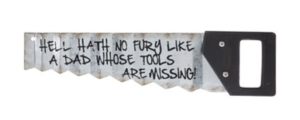By Becky Ferrell
I was browsing through one of my favorite craft stores when I ran across a sign. Technically, it’s probably classified as a “Man Cave” sign. But when I saw it, I started laughing and actually shed a couple tears. The sign? Made from a piece of corrugated metal and wood to look like an old hand saw:

If you read my previous blog on fork truck safety, you may remember that I grew up in a rather unconventional home, if you were a girl. The premise of my father and grandfather was simple: if you’re going to help, you’re going to learn how to do it yourself. And if you’re going to learn how to do it, you’re going to learn how to do it properly. No excuses.
With each project, there was a process. Analyze the project. Determine what tools were required. Fetch the tools. Do the project. Clean the tools and replace them in their proper location. My father’s workshop and tools were an open door to me. I could use anything, with one caveat: The tools were returned to their proper location, clean and ready to use the next time.
As a child, we all make mistakes. We do as adults, also. It’s how we learn, or should. Being held accountable for my mistakes was part of the process. Violate the rule so that the tool was not clean or not in its proper location, then I wasn’t allowed to use the workshop for a period of time.
5S of Lean Manufacturing
We all remember when “lean” became a “thing” in manufacturing, right? Part of the Toyota Production System that swept the U.S. starting in the late 70’s, shortly after the Japanese car maker started making inroads in our country. Most manufacturers took note of the strengths of TPS and moved to understand and implement the strategies, often starting with a basic process called “5S.”
Some learned the “S” in Japanese:
Seiri, Seiton, Seiso, Seiketsu, Shitsuke
Some learned the English:
Sort, Straighten, Sweep, Standardize, Sustain
Over the decades, the names of the steps have evolved and there’s even an 8-step process now, but it’s still rooted in the disciplined practice of 5S.
I do remember there were people and parts of the organization that struggled with the new process. Those in the office areas watched manufacturing work through their implementation, often hiding their laughter at some of the struggles. But in some cases, the laughter turned to some significant stress when 5S came for the office as well.
Getting leadership buy-in and support were crucial to successful implementation. The creation of audit processes proved essential to ensure organizations achieved “sustain.” And there were many departments that had to repeat the process, some several times.
Frankly, for me, it was a non-event. I watched others struggle, but really couldn’t understand the difficulty. Was it because I was that organized…? No, not really. In fact, I had some cleaning up to do of my own. BUT, following the process I felt almost a sense of “normal,” of relief, although at that time, I truly didn’t understand WHY.
Seeing that sign in the store made me suddenly understand. Decades before lean, my father understood the premise of 5S and taught its importance to a young child through repetition and support – and yes, some discipline.
These are lessons we can take to our workforce. Teach the correct process. Reinforce the process, reinstructing as necessary, and support the implementation and sustaining of it through audits and calibrations. Will discipline be necessary? Maybe. But my father never gave up, and neither should you.
Thanks, Dad.
Looking for help building new, efficient processes to help you succeed? High Value Manufacturing has Lean manufacturing experience and expertise. Give us a call; we’ll be glad to help!
Did you enjoy this blog? Search our blog library for other topics of interest: https://highvaluemanufacturingconsulting.com/blog/
